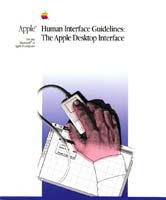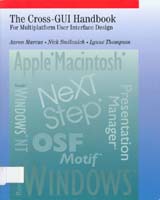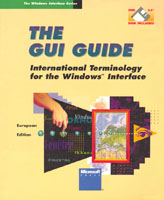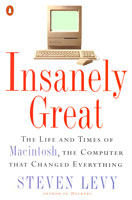|  |
The following is the list of GUI-related books, with reviews and – in some cases
– excerpts:
|  |
| |
 | |  |
|  |
 |   Apple Human Interface Guidelines Apple Human Interface Guidelines
The Apple Desktop Interface
Addison-Wesley, 1987
162 pages
This is the third edition of guidelines for creating interfaces with Macintosh GUI, published in mid-1988. It has been superceded many times. The updated Macintosh Human Interface Guidelines book was released in 1992, then the guidelines were made available freely on the website as PDF,  updated to Mac OS X (as Aqua Human Interface Guidelines), and eventually made compliant with Mac OS X 10.3 Panther, renamed again to Apple Human Interface Guidelines. When compared to this PDF, the original book seems surprisingly short and simple, but that’s just signum temporis, as GUIs back then were also unsophisticated. And that – looking at the recipes and foundations of the initial versions of the first popular GUI, and comparing them with the contemporary interfaces – seems its only use today. updated to Mac OS X (as Aqua Human Interface Guidelines), and eventually made compliant with Mac OS X 10.3 Panther, renamed again to Apple Human Interface Guidelines. When compared to this PDF, the original book seems surprisingly short and simple, but that’s just signum temporis, as GUIs back then were also unsophisticated. And that – looking at the recipes and foundations of the initial versions of the first popular GUI, and comparing them with the contemporary interfaces – seems its only use today.
 |
 |  Joseph Coleman Joseph Coleman
Apple Lisa: A user-friendly handbook
Tab Books Inc., 1984
308 pages
“A user-friendly handbook” is a guide to six applications of Lisa system (excluding LisaTerminal). After a short introduction of Lisa and its Desk Top Manager, the book proceeds with many exercises for people starting their adventures with GUIs. Without a real Lisa (or its emulator), the book loses much of its appeal, even though an extensive collection of screenshots might be worth a closer look.
 |
 |   Thierry Bardini Thierry Bardini
Bootstrapping
Douglas Engelbart, Coevolution, and the Origins of Personal Computing
Stanford University Press, 2000
284 pages
While possibly everyone even mildly interested in the history of GUIs will have heard of Doug Engelbart’s groundbreaking “mother of all demos” of oNLine System from 1968, there’s usually much less emphasis on its history, relevance and context. “Bootstrapping” provides this knowledge, giving a detailed history of Doug Engelbart’s “crusade” – starting with his studies and ending with the closure of Augmentation Research Center. It also positions NLS in a broader context of Engelbart’s vision of the symbiosis of the user and the system, which went much further and deeper than just the mouse and proto-hypertext (that’s not to say that these inventions do not get their fair share of attention in the book). Superbly researched, the book suffers from sometimes overly dry and scholarly tone, going into unnecessary details, and perhaps exhibiting too much sympathy for Engelbart. However, it’s worth its cover price, even if for accurate portrayal of the future that hasn’t been.
 |
 |  Kurt J. Schmucker Kurt J. Schmucker
The complete book of Lisa
Harper & Row, 1984
335 pages
This 1984’s book explains the ideas behind Lisa’s GUI and its seven applications. Since mouse-operated computers were a rarity 20 years ago, the author describes everything with a great level of detail – complete with screenshots of most menus, crucial dialog boxes, mouse pointers, etc. When read today, it is a fascinating testimony to where we started and how far have we gone. It’s unbelievable how many things were already there in Lisa’s system, but even more astonishing how often users had to put up with system’s limitations. The book also contains basic information about Apple Lisa, as well as tear-in-the-eye conclusion about Lisa’s future.
 |
 |      Aaron Marcus, Nick Smilonich, Lynne Thompson Aaron Marcus, Nick Smilonich, Lynne Thompson
The Cross-GUI Handbook
For Multiplatform User Interface Design
Addison-Wesley, 1994
304 pages
This book was released in 1995 and its main purpose is being a comparison of the popular GUIs: Macintosh, OSF/Motif, NeXTSTEP, OS/2’s Presentation Manager and Microsoft Windows. It tries to do it on various levels: visual, methodological, terminological, giving away free design tips in the process. However, the book has aged rather badly – it won’t be of much use to contemporary UI designers, and is simply too ugly to put on a representative bookshelf.
 |
 |   Markos Kounalakis, Doug Menuez Markos Kounalakis, Doug Menuez
Defying gravity
The making of Newton
First Glance Books, 1993
200 pages
I really wanted to recommend this book – a rare account of engineering efforts undertook to create Apple Newton – but I cannot do it with clear conscience. On the surface, “Defying gravity” should easily repeat the success of many stories of the birth of the Macintosh. But there’s something wrong about this book, something that – excuse the bad pun – defies description. Maybe it is the strange format? Or plain ugly visual design? Maybe it’s the peculiar page numbering scheme? Perhaps the stories are less captivating, and the photos too artistic? Might be all of that. However, the most important complaint from GUIdebook’s standpoint is that, save for two little photos, there’s absolutely no information about Newton’s unique GUI. The book glosses over the countless difficult decisions that must have been faced during its inception, instead focusing on yet another Newton stage presentation during yet another computer trade show. Pity.
 |
 |         Kevin Mullet, Darrell Sano Kevin Mullet, Darrell Sano
Designing Visual Interfaces
Communication Oriented Techniques
Prentice Hall, 1994
304 pages
“Designing Visual Interfaces” is not your typical GUI book with a lot of specific guidelines. The authors divided it into several chapters (“Elegance and simplicity,” “Scale, contrast, and proportion,” “Organization and visual structure,” “Module and program,” “Image and representation” and “Style”) and within each of them they present design principles, then proceed to common GUI errors, ending with useful techniques. There’s a lot of screenshots (and, what is commendable, big chunk of those comes from less known operating systems), but also many design examples of real life designs. This makes this 9-year-old, tastefully packaged book still relevant and useful. A very good and highly recommended volume for everyone interested in graphic and interface design.
 |
 |   Jeff Johnson Jeff Johnson
GUI bloopers
Don’ts and do’s for software developers and web designers
Morgan Kaufmann, 2000
584 pages
This is a book intended not for GUI historians (presented here are common Windows and Mac OS interface elements), but rather GUI practicioners and beginner GUI theorists. Described here at length are a couple of dozens of most common GUI blunders (such as using radio buttons where checkboxes are appropriate), with real life examples and design rules. The language is straightforward and accessible, but the whole 600-page book seems a little bit too drawn-out. Nevertheless, it is one-of-its-kind injection of GUI common sense, definitely worth getting familiar with.
 |
 |  The GUI Guide The GUI Guide
International Terminology for the Windows™ Interface
European Edition
Microsoft Press, 1993
239 pages
International word lists were an interesting appendix to 1995’s The Windows Interface Guidelines for Software Design, but two years earlier were put together for this book. It presents Windows 3.1 terms translated to 14 languages, sorted both by alphabet and by category. These lists seem a big waste of space, especially as they’re also present on an attached diskette (277 KB). However, first thirty pages slightly redeem the book, containing a condensed round-up of popular and obscure graphical elements of Windows 3.1 – with a lot of illustrated examples.
 |
 |     Susan L. Fowler, Victor R. Stanwick Susan L. Fowler, Victor R. Stanwick
The GUI Style Guide
Morgan Kaufmann, 1994
407 pages
The book suffers from the same kind of problems as The Cross-GUI Handbook. It’s already almost a decade old, it doesn’t even cover Windows 95, and it wasn’t that pretty to being with. However, contrary to the mentioned counterpart, it is focused more on presenting design ideas than simply pictures. For example, there are chapters on charts and graphs, colours, multimedia, and translating sofware.
 |
 |    William Horton William Horton
The icon book
Visual symbols for computer systems and documentation
John Wiley & Sons, 1994
432 pages
A very good book, explaining in depth all things iconic: from history and theory of the icon design, through various classifications of icons, to development and testing. Hundreds of icons serve as an example in the book and on the attached diskette (650 KB). What’s impressive is that they are not just lifted from various GUIs, but drawn by author especially for this occassion (however, the book also contains various real life case studies). Impressive and inspiring, even 10 years after the publish date.
 |
 |        Steven Levy Steven Levy
Insanely great
The life and times of Macintosh, the computer that changed everything
Penguin Books, 1995
312 pages
This is Yet Another Macintosh Story™ – sure, it flows quite nicely, but doesn’t really contain much more than any other book or good website on this topic. Why am I listing it here then? Two things: its first 100 pages, smoothly going from Memex to Apple Lisa, seem a very accessible introduction to GUI history, and the book ponders a lot about influence of mouse-driven computers on our everyday’s lives. “Insanely great” might not be the deepest book on the subject, but it should do well during a relaxing Sunday porch session, especially if you’re just starting getting to know the fascinating history of GUIs.
 |
 |        Steven Johnson Steven Johnson
Interface culture
How new technology transforms the way we create and communicate
Harper, 1997
264 pages
An interesting exercise in juxtaposing interfaces with historical and contemporary works of art (literature, architecture, paintings), and trying to define and predict cultural aspects and influences of interface design. This is quite a different read than all the other, more technical volumes presented here, and goes way beyond GUIs. For those wishing to expand their horizons, this could be a demanding, but satisfying detour.
 |
 |  Robert Carr, Dan Shafer Robert Carr, Dan Shafer
The Power of PenPoint
Addison-Wesley, 1991
342 pages
This book quickly goes into technical details for programmers, but first gives us a fascinating overview of the ill-fated PenPoint NUI (Notebook User Interface), unique in many ways. The first two chapters – reproduced on this site – are of special interest, explaining in detail the goals and rationales of PenPoint, as well as the new or revisited interface concepts.
 |
 |  Virginia Howlett Virginia Howlett
Visual interface design for Windows
Effective user interfaces for Windows® 95, Windows NT™, and Windows 3.1™
Wiley, 1996
230 pages
A thin book that can be enjoyed in one evening, “Visual interface design for Windows” is in many ways a good companion to Designing visual interfaces. It’s slightly more specific, but don’t let that title fool you – many advices are universal, and Windows serves mainly only as an example. And what an example it is! Virginia Howlett, a leader of Microsoft user interface team for Windows 95 (and the co-author of the famous Verdana font) made screenshots of various multimedia titles, prototypes and before-and-after comparisons of redesigned software. And these screenshots seem to be the book’s finest asset.
 |
 |  The Windows Interface Guidelines for Software Design The Windows Interface Guidelines for Software Design
An Application Design Guide
Microsoft Press, 1995
576 pages
This official set of guidelines for creating Windows-compliant user interfaces was published in 1995, and explains in depth then just released Windows 95. Profusely illustrated and nicely printed on a good quality paper, it seems to cover all the necessary bases on its 550+ pages. It might not be the best lecture ever – the text is rather dry and gets boring after a while – but for a reference book that it is, it’s hard to point out any serious problems. Even when Windows 95-like interface will be long but obsolete, the book might be a joy to riffle through. International word lists, presenting Windows terms translated to 25 languages, are a nice addition.
 |
|  |
| |
|
 Home
Home 


 Home
Home 